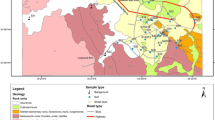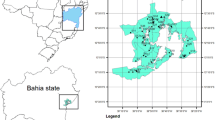Abstract
The South African National Road (N3) in the KwaZulu-Natal province is one of the major transportation routes from the Durban harbor. In this study, metal concentrations in Bidens pilosa L., which grows alongside the N3, and soil were determined using inductively coupled plasma — optical emission spectrometry to evaluate the impact of soil quality on the uptake. Furthermore, the distribution of Pb and Cd was mapped using the geographic information system (GIS) approach to identify the potential benefits of spatial data applications in soil studies. Plant concentrations of toxic metals, especially Pb, were high and were linked to high soil concentrations. The target hazard quotients indicated a low risk of adverse effects due to Cd exposure and increased risk due to As and Pb exposure. The carcinogenic risk was high for As and Cd exposure at all sites and Pb at 40% of the sites. Soil quality indicators (geoaccumulation indices and enrichment factors) showed soils to be moderate to heavily contaminated. Principal component analysis indicated different anthropogenic sources of contamination, including vehicular emissions and a combination of industrial, agricultural, and social impacts. Kriging interpolation depicted the spatial diffusion of Cd and Pb concentrations throughout the study area with different hot-spot areas of metal contamination for these two metals. The study demonstrated that the plants growing along national roads are not suitable for human consumption.






Similar content being viewed by others
Availability of data and materials
All data generated or analyzed during this study are included in this published article.
References
Agency for Toxic Substances and Disease Registry. (2004). Toxicological profile for cobalt. U.S. Department of Health and Human Services, Atlanta, Georgia, p. 17.
Atafar, Z., Mesdaghinia, A., Nouri, J., Homaee, M., Yunesian, M., Ahmadimoghaddam, M., & Mahvi, A. H. (2010). Effect of fertilizer application on soil heavy metal concentration. Environmental Monitoring and Assessment, 160(1–4), 83.
Bigdeli, M., & Seilsepour, M. (2008). Investigation of metals accumulation in some vegetables irrigated with wastewater in Shahre Rey-Iran and toxicological implications. American Eurasian Journal of Agricultural Environmental Science, 4(1), 86–92.
Bushell, A. J., & Williamson, J. (1995). The fate of trace elements in coal during gasification. Coal Science and Technology, 24, 1967–1970.
Codex Alimentarius Commission, Joint FAO/WHO Food Standards Programme, and World Health Organization. (2001). Codex Alimentarius: General requirements (food hygiene) (Vol. 1). Food and Agriculture Organisation.
Coetzee, J. J., Bansal, N., & Chirwa, E. M. N. (2020). Chromium in environment, its toxic effect from chromite-mining and ferrochrome industries, and its possible bioremediation. Exposure and Health, 12, 51–62.
Department of Environmental Affairs. (2010). Framework of the management of contaminated land, Government White Paper, South Africa.
Department of Environmental Affairs. (2012). National environmental management: Waste Act, 2008 (Act no.59 of 2008). Draft national norms and standards for the remediation of contaminated land and soil quality, South Africa.
Department of Health. (2004). Foodstuffs, Cosmetics and Disinfectants Act (Act No. 54 of 1972), Government Gazette, South Africa.
Department of Water Affairs and Forestry (DWAF). (2005). Waste management series. Minimum requirements for the handling, classification and disposal of hazardous waste. Draft Third Edition, Pretoria, South Africa.
De Vos, W., Batista, M. J., Demetriades, A., Duris, M., Lexa, J., Lis, J., & O’Connor, P. J. (2005). Metallogenic mineral provinces and world-class ore deposits in Europe. Geochemical Atlas of Europe, 1, 43–49.
Giannouli, M., de Haan, P., Keller, M., & Samaras, Z. (2007). Waste from road transport: Development of a model to predict waste from end-of-life and operation phases of road vehicles in Europe. Journal of Cleaner Production, 15(11), 1169–1182.
Gulten, Y. (2011). Heavy metal contamination of surface soil around Gebze industrial area. Turkey. Microchemical Journal, 99(1), 82–92.
Herselman, J. E. (2007). The concentration of selected trace metals in South African soils (Doctoral dissertation). University of Stellenbosch, South Africa.
Herselman, J. E., Steyn, C. E., & Fey, M. V. (2005). Baseline concentration of Cd Co, Cr, Cu, Pb, Ni and Zn in surface soils of South Africa: Research in action. South African Journal of Science, 101(11–12), 509–512.
Hjortenkrans, D., Bergbäck, B., & Häggerud, A. (2006). New metal emission patterns in road traffic environments. Environmental Monitoring and Assessment, 117(1–3), 85–98.
Javed, M., & Usmani, N. (2016). Accumulation of heavy metals and human health risk assessment via the consumption of freshwater fish Mastacembelus armatus inhabiting, thermal power plant effluent loaded canal. Springerplus, 5, 776.
Kortei, N. K., Heymann, M. E., Essuman, E. K., Kpodo, F. M., Akonorb, P. T., Lokpor, S. Y., Boadi, N. O., Ayim-Akonor, M., & Tetley, C. (2020). Health risk assessment and levels of toxic metals in fishes (Oreochromis noliticus and Clarias anguillaris) from Ankobrah and Pra basins: Impact of illegal mining activities on food safety. Toxicology Report, 7, 360–369.
Krivoruchko, K., & Gribov, A. (2019). Evaluation of empirical Bayesian kriging. Spatial Statistics, 32, 1–29.
Loke, P. F., Kotzé, E., & Du Preez, C. C. (2012). Changes in soil organic matter indices following 32 years of different wheat production management practices in semi-arid South Africa. Nutrient Cycling in Agroecosystems, 94, 97–109.
Mahlangeni, N. T., Moodley, R., & Jonnalagadda, S. B. (2016). The distribution of macronutrients, anti-nutrients and essential elements in nettles, Laportea peduncularis susp. peduncularis (river nettle) and Urtica dioica (stinging nettle). Journal of Environmental Science and Health, Part B, 51(3):160–169.
Mani, D., & Kumar, C. (2014). Biotechnological advances in bioremediation of heavy metals contaminated ecosystems: An overview with special reference to phytoremediation. International Journal of Environmental Science and Technology, 11, 843–872.
Mendiola, L. L., Dominguez, M. C. D., & Sandoval, M. R. G. (2008). Environmental assessment of active tailings pile in the state of Mexico (Central Mexico). Research Journal of Environmental Sciences, 2(3), 197–208.
Moodley, R., Koorbanally, N., & Jonnalagadda, S. B. (2012). Elemental composition and fatty acid profile of the edible fruits of Amatungula (Carissa macrocarpa) and impact of soil quality on chemical characteristics. Analytica Chimica Acta, 730, 33–41.
Muller, G. (1969). Index of Geoaccumulation in sediments of the Rhine River. Geology Journal, 2, 109–118.
Nogaim, Q. A., Makarem, M., Alwah, M., & Atef, M. (2013). Survey of some heavy metals in Yemeni vegetables. Merit Research Journal of Food Science and Technology, 1(3), 36–42.
Panagos, P., Ballabio, C., Lugato, E., Jones, A., Borrelli, P., Scarpa, S., Orgiazzi, A., & Montanarella, L. (2018). Potential sources of anthropogenic copper inputs to European agricultural soils. Sustainability, 10, 2380.
Rezapour, S., Golmohammad, H., & Ramezanpour, H. (2014). Impact of parent rock and topography aspect on the distribution of soil trace metals in natural ecosystems. International Journal of Environmental Science and Technology, 11(7), 2075–2086.
Rudnick, R. L. (2014). Composition of the continental crust. Treatise on Geochemistry, 3, 1–64.
Sahu, C., & Basti, S. (2021). Trace metal pollution in the environment: A review. International Journal of Environmental Science and Technology, 18, 211–224.
Sakinatu, I., & Ashraf, M. A. (2017). Impact of soil erosion and degradation on water quality: A review. Geology, Ecology, and Landscapes, 1(1), 1–11.
Sharma, A., Katnoria, J. K., & Nagpal, A. K. (2016). Heavy metals in vegetables: Screening health risks involved in cultivation along wastewater drain and irrigating with wastewater. Springerplus, 5(488), 1–16.
Song, B., Lei, M., Chen, T., Zheng, Y., Xie, Y., Li, X., & Gao, D. (2009). Assessing the health risk of heavy metals in vegetables to the general population in Beijing, China. Journal of Environmental Science, 21, 1702–1709.
Steenland, K., & Boffeta, P. (2000). Lead and cancer in humans: Where are we now? American Journal of Industrial Medicine, 38, 295–299.
Stoffers, P., Glasby, G. P., Wilson, C. J., Davis, K. R., & Watter, P. (1986). Heavy metal pollution in Wellington Harbour. New Zealand Journal of Marine and Freshwater Research, 20, 495–512.
Suman, S. (2010). Magnesium and surface engineering. Surface Engineering, 26(5), 313–316.
Szwalec, A., Mundała, P., Kędzior, R., & Pawlik, J. (2020). Monitoring and assessment of cadmium, lead, zinc and copper concentrations in arable roadside soils in terms of different traffic conditions. Environmental Monitoring and Assessment, 192, 155.
Tian, H., Cheng, K., Wang, Y., Zhao, D., Lu, L., Jia, W., & Jiming, H. (2012). Temporal and spatial variation characteristics of atmospheric emissions of Cd, Cr, and Pb from coal in China. Atmospheric Environment, 50, 157–163.
USEPA (United States Environmental Protection Agency). (2011). USEPA Regional Screening Level (RSL) Summary Table: November 2011. Available at: http://www.epa.gov/regshwmd/risk/human/Index.htm
Water Research Commission. (1997). Permissible utilization and disposal of sewage sludge. 1st Edition, TT85–97.
WHO. (1996). Guidelines for drinking-water quality, Vol. 2: Health Criteria and Other Supporting Information, 2nd Edn.
Yoshida, A., Ohata, S., Moteki, N., Adach, K., Mori, T., Koike, M., & Takami, A. (2018). Abundance and emission flux of the anthropogenic iron oxide aerosols from the East Asian continental outflow. Journal of Geophysical Research: Atmospheres, 123, 11194–11209.
Zaidi, M. I., Asrar, A., Mansoor, A., & Farooqui, M. A. (2005). The heavy metal concentrations along with roadside trees of Quetta and its effects on public health. Journal of Applied Science, 5(4), 708–711.
Acknowledgements
The authors are grateful to the University of KwaZulu-Natal for financial assistance.
Funding
The authors acknowledge the University of KwaZulu-Natal for financial assistance.
Author information
Authors and Affiliations
Contributions
Conceptualization: RM and OM. Investigation and data curation: ZBI. Formal analysis and validation: ZBI. Project administration and supervision: RM and OM. Writing—original draft: ZBI. Writing—review and editing: RM and OM. All authors read and approved the final manuscript.
Corresponding author
Ethics declarations
Ethics approval and consent to participate
Not applicable.
Consent for publication
Not applicable.
Competing interests
The authors declare that they have no competing interests.
Additional information
Publisher's Note
Springer Nature remains neutral with regard to jurisdictional claims in published maps and institutional affiliations.
Supplementary Information
Below is the link to the electronic supplementary material.
Rights and permissions
About this article
Cite this article
Batwa-Ismail, M.Z., Moodley, R. & Mutanga, O. Elemental analysis of soils along the South African National Road (N3) — a combined approach including statistics, pollution indicators, and geographic information system (GIS). Environ Monit Assess 193, 559 (2021). https://doi.org/10.1007/s10661-021-09374-7
Received:
Accepted:
Published:
DOI: https://doi.org/10.1007/s10661-021-09374-7




